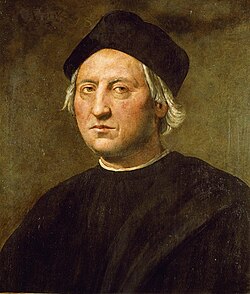History
8th - early 5th century BC: Greek settlement
In Archaic Greece, trading and colonizing activities of the Greek tribes from the Black Sea, Southern Italy (the so-called "Magna Graecia") and Asia Minor propagated Greek culture, religion and language around the Mediterranean and Black Sea basins. Greek city-states were established in Southern Europe, northern Libya and the Black Sea coast, and the Greeks founded over 400 colonies in these areas. [6] Alexander the Great's conquest of the Achaemenid Empire marked the beginning of the Hellenistic period, which was characterized by a new wave of Greek colonization in Asia and Africa; the Greek ruling classes established their presence in Egypt, southwest Asia, and Northwest India. [7] Many Greeks migrated to the new Hellenistic cities founded in Alexander's wake, as geographically dispersed as Uzbekistan [8] and Kuwait. [9]
1450-1800: Emigration to the Americas

The European continent has been a central part of a complex migration system, which included swaths of North Africa, the Middle East and Asia Minor well before the modern era. Yet, only the population growth of the late Middle Ages allowed for larger population movements, inside and outside of the continent. [10] The European exploration of the Americas stimulated a steady stream of voluntary migration from Europe.
Roughly one and a half million Europeans settled in the New World during the period of 1500 and 1800. [3]
Spanish and Portuguese
About 200,000 Spaniards settled in their American provinces prior to 1600, a small settlement compared to the 3 to 4 million Amerindians who lived in Spanish territory in the Americas.
During the 1500s, Spain and Portugal sent a steady flow of government and church officials, members of the lesser nobility, people from the working classes and their families averaging roughly three-thousand people per year from a population of around eight million. A total of around 437,000 left Spain in the 150-year period from 1500 to 1650 mainly to New Spain, [11] Peru in South America, and the Caribbean Islands. It has been estimated that over 1.86 million Spaniards emigrated to the Americas in the period between 1492 and 1824, one million in the 18th century (during this century, immigration was encouraged by the new Bourbon dynasty in Spain), with millions more continuing to immigrate following independence. [12]
Between 1500 and 1700, 100,000 Portuguese crossed the Atlantic to settle in Brazil. However, with the discovery of numerous highly productive gold mines in the Minas Gerais region, the Portuguese emigration to Brazil increased by fivefold. From 1500, when the Portuguese reached Brazil, until its independence in 1822, from 500,000 to 700,000 Portuguese settled in Brazil, with 600,000 in the 1700s. [13] Though not usually studied, this represented one of the largest movements of European populations to their colonies to the Americas during the colonial times. According to historian Leslie Bethell, "In 1700 Portugal had a population of about two million people." During the 18th century hundreds of thousands left for the Portuguese Colony of Brazil, despite efforts by the crown to place severe restrictions on emigration. [14]

In the 18th century, thanks to the gold rush, the capital of the province of Minas Gerais, the town of Vila Rica (today, Ouro Preto) became for a time one of the most populous cities in the New World. This massive influx of Portuguese immigration and influence created a city which remains to this day, one of the best examples of 18th century European architecture in the Americas. [3] The 2022 Brazilian census showed that 41.1% of Minas Gerais state identified as white Brazilian of European descent with the rest possibly having mixed Portuguese origins. [15] However, the development of the mining economy in the 18th century raised wages and employment opportunities in the Portuguese colony and emigration increased: in the 18th century alone, about 600,000 Portuguese settled in Brazil. [13] [16]
British, Irish and German settlement in North America

Between one-half and two-thirds of European immigrants to the Thirteen Colonies between the 1630s and the American Revolution came under indentures. [17] The practice was sufficiently common that the Habeas Corpus Act 1679, in part, prevented imprisonments overseas; it also made provisions for those with existing transportation contracts and those "praying to be transported" in lieu of remaining in prison upon conviction. [18] In any case, while half the European immigrants to the Thirteen Colonies had been indentured servants, at any one time they were outnumbered by workers who had never been indentured, or whose indenture had expired. Free wage labor was more common for Europeans in the colonies. [19]
Indentured persons were numerically important, mostly in the region from Virginia north to New Jersey. Other colonies saw far fewer of them. The total number of European immigrants to all 13 colonies before 1775 was about 500,000–550,000; of these, 55,000 were involuntary prisoners. Of the 450,000 or so European arrivals who came voluntarily, Tomlins estimates that 48% were indentured. [20] About 75% were under the age of 25. The age of legal adulthood for men was 24 years; those over 24 generally came on contracts lasting about 3 years. [20] Regarding the children who came, Gary Nash reports that, "many of the servants were actually nephews, nieces, cousins and children of friends of emigrating Englishmen, who paid their passage in return for their labour once in America." [21]
Figures for immigration in the Spanish Empire in 1650–1800 and in Brazil in 1700–1800 are not given in the table. Of the 322,000 from Britain, 190,000–250,000 were Scottish and Irish. [3]
| Country of origin | Number | Period |
|---|---|---|
| Spain | 437,000 | 1500–1650 |
| Portugal | 100,000 | 1500–1700 |
| 500,000 | 1700–1760 | |
| Great Britain | 400,000 | 1607–1700 |
| Great Britain | 322,000 | 1700–1780 |
| France | 51,000 | 1608–1760 |
| Germany (Southwestern, totals) | 100,000 | 1683–1783 |
| Switzerland | ||
| Totals | 1,410,000 | 1500–1783 |
In North America, immigration was dominated by British, German, Irish and other Northern Europeans. [22] Emigration to New France laid the origins of modern Canada, with important early immigration of colonists from Northern France. [16]
From 1760 to 1820, the final phase of colonial immigration became dominated by free settlers and was marked by a huge increase in British immigrants to North America and the United States in particular. In that period, 871,000 Europeans immigrated to the Americas, of which over 70% were British (including Irish in that category). Many independent farmers and tenants emigrated to establish farms and plantations, as well as craftsmen. [23]
19th century to 20th century

There was mass European emigration to the Americas, Australia, New Zealand, and South Africa in the 19th and 20th centuries, as a result of a dramatic demographic transition in 19th-century Europe, subsequent wars and political changes on the continent. From the end of the Napoleonic Wars in 1815 to the end of World War I in 1918, millions of Europeans emigrated. Of these, 71% went to North America, 21% to Central and South America and 7% to Australia. About 11 million of these people went to Latin America, of whom 38% were Italians, 28% were Spaniards and 11% were Portuguese. [24]
| Destination | Percent |
|---|---|
| United States | 70.0% |
| Latin America | 12.0% |
| Russian Siberia | 9.0% |
| Canada, Australia, New Zealand, South Africa | 9.0% |
| Total | 100.0% |
Immigration to Brazil

In Brazil, the proportion of immigrants in the national population was much smaller. Immigrants tended to be concentrated in the central and southern parts of the country. The proportion of foreigners in Brazil peaked in 1920, at just 7 percent or 2 million people, mostly Portuguese and Italians. However, the influx of 4 million European immigrants between 1870 and 1920 significantly altered the racial composition of the country. [22] From 1901 to 1920, immigration was responsible for only 7 percent of Brazilian population growth, but in the years of high immigration, from 1891 to 1900, the share was as high as 30 percent (higher than Argentina's 26 percent in the 1880s). [26]
Country of arrivals
The countries in the Americas that received a major wave of European immigrants from 1820s to the early 1930s were: the United States (32.5 million), Argentina (6.5 million), Canada (5 million), Brazil (4.5 million), Cuba (1.4 million), Chile (728,000), Uruguay (713,000). [27]

Other countries that received a more modest immigration flow (accounting for less than 10 percent of total European emigration to Latin America) were: Mexico (326,000), Colombia (126,000), Puerto Rico (62,000), Peru (30,000), and Paraguay (21,000). [27] [26]
| Destination | Years | Arrivals | Ref(s) |
|---|---|---|---|
| 1821–1932 | 32,244,000 | [2] | |
| 1856–1932 | 6,405,000 | [2] | |
| 1831–1932 | 5,206,000 | [2] | |
| 1818–1932 | 4,431,000 | [2] | |
| 1821–1932 | 2,913,000 | [2] | |
| 1901–1931 | 857,000 | [2] | |
| 1881–1932 | 852,000 | [2] | |
| 1882–1932 | 726,000 | [2] | |
| 1836–1932 | 713,000 | [2] | |
| 1821–1932 | 594,000 | [2] | |
| 1901–1931 | 326,000 | [2] |











